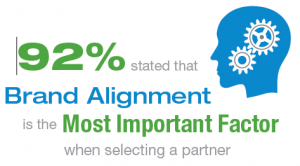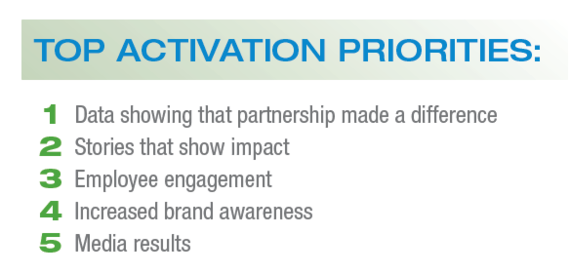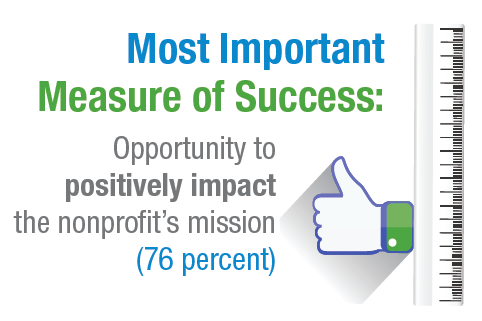What do ________ want?
It's a fundamental question when it comes to fundraising and marketing in general. If you know what _______ wants, then you just need to give 'it' to them. And while it's not easy to just create 'it', communicate 'it' and deliver 'it' to the right people, it sure beats doing all that work and finding out they don't even want 'it' in the first place.
But what does a company want in their nonprofit partner?
That's the question the good folks at For Momentum were looking to answer with their 2015 Corporate Partner Survey. Remember, always be careful with survey responses because what people say is not always what they actually do. This can be especially true when it comes to areas like philanthropy, parenting, and performance. Generally speaking, we perceive ourselves in a positive light and want others to perceive us that way as well. This makes us respond to questions as the best versions of ourselves - something we may not always be in all situations in real life.
Okay, survey caveat aside, there are still some great insights in the report (insights - not facts). Here're a few key points for you.
Brand and Values Alignment
A company's brand is paramount to its success and identity so it is little surprise that they are only interested in aligning themselves with partners whose brand fits with theirs. This can be size or influence, like Coca-Cola and WWF for example, or more with set priorities like Bell and their commitment to mental health.
This also isn't too surprising. Companies fit more under the 'major donor' category of how they should be treated (even though they often need a lot more effort and account for less revenue). And unlike donors, whose motivations can often be complex, a mix of factors and change over time, companies will often have established criteria for supporting organizations. You just need to invest the time to understand their focus and try to match up your organization to theirs.
Also, a business 101 reminder, companies exist to maximize shareholder wealth (publicly traded ones at least). Exercises in charity and philanthropy by companies must help them towards their goal in some way. Increased sales, greater brand or employee retention are examples of possible benefits to companies by working with nonprofit partners. And while companies, particular younger ones, are focusing more on social benefit, that focus is still very much tied to a fundamental belief that it will in some way help them meet their business and bottom line objectives.
Impact (And Proof)
Data is a form of reporting to shareholders, stakeholders and customers. It's incredibly important for the company to have so they can show those groups, and the world, that they are in fact helping make a difference. This is not typically an area of strength for nonprofits and it can be quite complex and costly to do. But that's where #2 on the list, stories that show impact, comes in. In the absence of quantifiable data and robust tracking measures, great individual stories that show impact can be great substitutes.
Keep in mind the two audiences for companies as well. The numbers are great for annual reports, board members and financial types but the stories of impact can work wonders for employees, customers, and the public. It's best to have both and have them work hand in hand.
This is the one I raised the biggest eyebrow at. I do believe that companies want to help their nonprofit partners, but the #1 most important measurement of success for partnerships is the opportunity to impact the nonprofit's mission? It sounds like a result from a nonprofit focused survey or a leading question, but the fact remains that impact, through the nonprofit's work, is important to decision makers.
This is great and a way for companies to develop tighter relationships with nonprofits, see more impact in their community and provide better employee engagement (more on that later). It's also an opportunity for smaller, local nonprofits to work with bigger companies with larger budgets and more developed employee giving programs.
Employee Engagement
Last, but not least, are the employees themselves. Having employees engage with their nonprofit partners provides a great story for the company to tell - to future employees and the public at large - but also strengthens the bonds between the two organizations. It's one thing to write a cheque, another to fundraise from staff and yet another to have people give up their time and get their hands dirty with an organization.
Employee engagement is also where nonprofits can often get the most return out of a corporate partner. Employees become volunteers. Volunteers become donors. Donors become regular supporters. And because these folks live and work together, day in and day out, you have some already established networks that advocates and fans can make great inroads into.
And based on these insights, here are...
5 Things Nonprofits Can Do To Attract Corporate Partners
Make it clear, to everyone in every place, why you exist, what you do and how you do it. Don't try to be broad and cater to every company's needs (or every person's needs for that matter). That's not how strong brands are made and great partners attracted.
2. Show Your Impact (And Their Impact)
Do your utmost to track what is important for your corporate partner - impact. This could look different for the corporate partner than it does for you however. They may want to know how many hours their employees volunteered or projects they supported financially. Specifically. In combination with the stats and data, or instead of if you must, provide some great and personal stories of impact.
3. Engage Employees
Create programs, opportunities and strategies that can be used by corporate partners to engage their employees. Volunteer days, events to sponsor and attend and campaigns with fundraising challenges are just three ways that can make it easy for the company to say 'yes' and activate their staff.
4. Work Local
If you are a local organization, or even just based locally, look to those local companies, branches and divisions. They often have control over their own destinies, or some of it, and can lead to bigger, national partnerships and projects.
5. Know Your Donor... er... Corporate Partner
Back to marketing 101. Know what the company wants. Do some research, ask their employees if you can or try to get an informational interview to find out more. The more you know about their needs, the better you can position your organization to be a great partner for them.
More On The Subject
This post originally appeared on re: charity and can be read here.






